- Comics
- Comics Reviews
- Manga
- Comics Reviews
- European Comics
- News
- Comics News
- Press Releases
- Columns
- Spotlight
- Digital Comics
- Webcomics
- Cult Favorite
- Back Issues
- Webcomics
- Movies
- Toys
- Store
- More
- About
By Philip Schweier
August 31, 2011 - 19:33
Following the huge success of Superman
– The Movie in 1978, film producers began looking for other
baby-boomer material to mine. The success of Star Wars (1977) and
Superman made it clear there was gold
in them thar fantasies, so film producers latched onto that other 1950s hero of
the cathode ray tube, the Lone Ranger.
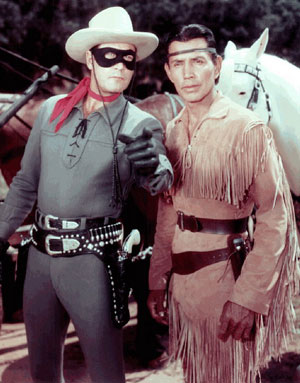
Clayton Moore and Jay Silverheels as the Lone Ranger and Tonto
That daring and resourceful masked rider of the plains had enjoyed stellar
success in his day. Created by radio scribe Fran Striker for WXYZ radio in
1933, the Lone Ranger was a mainstay of the Golden Ago of Radio until the
show’s end in 1956. Concurrently, beginning in 1949, Clayton Moore began
portraying the famous masked man in a TV series that lasted until 1957. Two
feature films followed, co-starring Jay Silverheels as the masked man’s loyal
Indian friend Tonto.
In the late 1960s and early ‘70s, both actors reprised their roles for a
handful of commercials, most notably Aqua Velva and Totino’s Pizza Rolls. Moore
also served as spokesman for Dodge, making personal appearances at auto
dealerships all over the country (For a great story about such an appearance, click here.)
Moore was a rare personality in that he fully embraced the ideals of the Lone
Ranger: honesty, good citizenship and justice. He served as a role model to
millions of children who grew up watching the series over the decades. In
between the occasional acting job, he continued to make personal appearances as
the Lone Ranger at schools, hospitals and county fairs, thrilling fans of all
ages with the blessing of the Wrather Corporation, which owned the Lone Ranger.
In the late 1970s, when plans for a new Lone Ranger film were announced, the
Wrather Corp. secured a court order to prevent Moore from making personal
appearances as the Lone Ranger. One might believe that having an independent
individual make personal appearances on behalf of your movie would be a publicity
bonanza, but the producers felt otherwise. They wanted to distance themselves
from previous interpretations, and in their eyes, Moore’s efforts would only
harm their film. It was believed that Moore’s association would undermine the
new film, The Legend of the Lone Ranger (1981), and that some might
think the film would star the 65-year-old actor.
This move proved to be a public relations disaster. Longtime fans,
many well into adulthood with children of their own, were outraged. While the
film’s producers couldn’t prevent Moore from making personal appearances, the
actor was required to avoid any mention or affiliation with the Lone Ranger. He
still appeared in cowboy regalia, sporting a very modern pair of sunglasses in
place of the trademark black mask. He counter-sued the Wrather Corp. and was
able to resume his appearances in costume, which he continued to do until
shortly before his death in 1999.
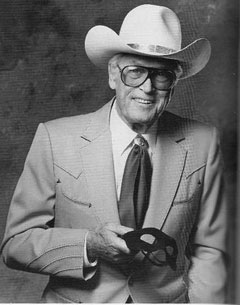
Clayton Moore
In retrospect, one might question which is worse: to be kicked to the curb by
the producers of this cinematic stinkbomb, or to be endorsed? Irate fans of the
Lone Ranger rallied in support of Moore, encouraging the filmmakers to ally
themselves with their hero, hoping he might be given some acknowledgement for
his pivotal place in the character’s history.
In Superman – The Movie, Kirk Alyn and Noel Niell, who appeared
together as Superman and Lois Lane in the serials of the 1940s, enjoyed cameo
appearances as the parents of a young Lois Lane. It seemed only right that the
producers of the Legend of the Lone Ranger acknowledge Moore in a similar
way. Not only did they fail to do so, they instead favored actor John Hart with
a cameo.
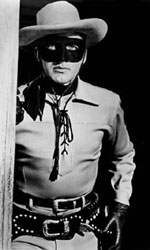
John Hart as the Lone Ranger
During the run of the original series, Moore was inexplicably replaced by Hart
in the title role. Some sources say it was due to a salary dispute, which Moore
denied in his 1996 autobiography I Was That Masked Man. Perhaps the
producers of the show at the time were merely trying to head off a potential
salary increase by replacing him with another actor, but sharp-eyed viewers
weren’t fooled by the mask. After two seasons in the role, Hart was gone and
Moore reinstated.
So for producers of the 1981 film to acknowledge this “usurper” to the mask
only aggravated fans further. But it was merely one of many poor choices in
casting for the film.
Starring as the Lone Ranger was an unknown actor named Klinton
Spilsbury. This would prove to be his only significant role to date (according
to IMDB.com), and he quickly faded into the obscurity from whence he came.
Rumor has it he was never permitted to speak at public appearances, such as the
Rose Bowl Parade, in which he and co-star Michael Horse appeared in costume,
mounted on their respective movie horses. Later, it was revealed that
Spilsbury’s dialogue was dubbed by actor James Keach.
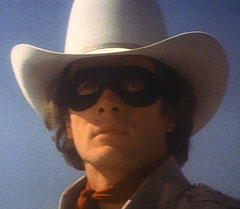
Klinton Spilsbury as the Lone Ranger
Another questionable casting choice was Christopher Lloyd as the film’s
villain, Butch Cavendish. Lloyd had achieved fame the lovable Jim Ignatowski on
the ABC sit-com Taxi. While he later went on to become a highly respected
character actor, the role of the drug-addled cabbie was still very fresh in the
minds of the audience.
The film presented the origin of the Lone Ranger, in a long drawn-out sequence
seemingly designed to explain every single facet of the legend, from the
meaning of the term “kemosabe” and his friendship with Tonto to why John Reid
(the Lone Ranger’s real name) was the pure-as-silver Western
hero-in-the-making. By rescuing President Ullysses S. Grant (Jason Robards)
from the evil clutches of Cavendish, the Lone Ranger is awarded carte blanch to
operate throughout the West on the side of justice.
One noteworthy moment of the film was sequence in which stuntman Terry Leonard
duplicated a stunt originally performed by master stuntman Yakima Canutt in Stagecoach
(1939). It required Leonard to jump from his horse to the team pulling a
stagecoach, only to seemingly fall between the horses and drop to the ground as
the stage passes over him. Leonard had performed a very similar stunt in Raiders
of the Lost Ark, which was released just a few weeks later.
Nevertheless, the fact that action fans would see almost identical stunts in
two separate movies left many moviegoers feeling one was merely copying the
other. Granted, it could be argued they were both “borrowing” from Stagecoach,
but Raiders of the Lost Ark certainly kept the stunt fresh,
whereas Legend of the Lone Ranger merely copied it.
Inevitably, the movie opened to horrible reviews, unresponsive audiences and a
lackluster box office performance. It disappeared quickly, becoming another
statistic in red ink on the financial ledgers of The Wrather Corp. With a
budget of $18 million, the film’s gross was $12.6 million, according to the
Internet Movie Data Base.
As mentioned, Christopher Lloyd’s career suffered little, as he
achieved success in the Back to the Future films and many
other character roles. Jason Robards was already a successful actor and he
weathered the storm as well. Michael Horse went on to appear in the
critically-acclaimed Twin Peaks.
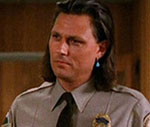
Michael Horse
But Klinton Spilsbury? He’s faded from sight altogether, leaving many a trivia
master to ponder, “Who was that masked man?” According to the IMDB.com, he has
never appeared in another film. Mr. Spilsbury, if you’re out there, let’s hear
from you. No recriminations. You’re as much a victim of bad production choices
as we audience members were.
Praise and adulation? Scorn and ridicule? E-mail me at
philip@comicbookbin.com.